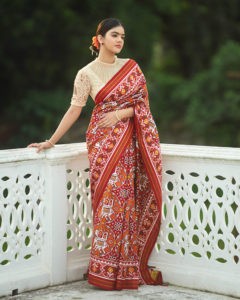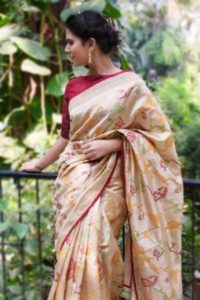
Traditional patola sarees form Gujarat
Traditional patola sarees form Gujarat
Patola Saree
Patola is known as the Queen of sarees for its lavish and illustrious silk and complicated geometrical designs with the utilization of rich verdure.
The Banarasi Patola utilize the perplexing meenakari cutwork procedure to weave the sarees and dupattas though in the Patolas from Gujarat the system utilized is entirely unexpected.
The Warp and Weft are colored in the example of the saree and after that woven with extraordinary numerical accuracy.
If one could discuss a legend in weaves, Patola silks would be its very encapsulation. When a select legacy of eminence and privileged, patola sarees were and still are prized ownership, worn solely on uncommon events like Vedic ceremonies and weddings. Patola sarees are viewed as sacrosanct in various networks. These handwoven marvels are the result of months and long periods of repetitive work and each piece in itself is extraordinary as they can never be imitated. Its colossal worth isn’t a result of its multifaceted design yet in addition on account of the enormous measure of expertise and diligence that goes into making it.
Root and history
A twofold ikat weave, Patola sarees started in the town of Patan in Gujarat. It is proposed that 700 silk weavers of the Salvi rank of Karnataka and Maharashtra moved to Gujarat in the twelfth century to secure the support of the Solanki Rajputs, the decision class of Gujarat and parts of Rajasthan around then.
Weaving process
The initial step includes tying off the yarn with cotton string as indicated by the example that has been chosen. The tying of yarn is finished by an accomplished ace craftsman as it is a mind-boggling and tedious procedure. Estimations can be as little as 1/100th of an inch and require cautious investigation. The yarn experiences numerous cycles of tying and coloring, following a particular request of hues. Dislodging of even a solitary yarn can aggravate the structure course of action and make the whole arrangement of yarns repetitive. At Artisan Glory, we make sure that we bring you the best of Patola sarees directly from the weavers.
Each shading has a one of a kind spot in the saree and the structure must be painstakingly adjusted while weaving. Such multifaceted nature requires extraordinary accuracy and persistence. A remarkable component of the Patola loom is that it is tilted to the other side and requires two individuals to sit and cooperate on only one saree. It can take a half year to a year or significantly more, contingent upon the length just as the multifaceted design of the example to make one of these Patola sarees.
Extraordinary highlights
Both the twist and the weft string are colored in twofold ikat Patolas. This implies the weaving procedure necessitates substantially more fixation and exactness. Indeed, even a small misstep can destroy the whole structure. As a result of the extraordinary procedure, Patola sarees are reversible and appear to be identical on the two sides. Frequently, even the weaver can’t differentiate. They are likewise very well known for their energetic hues and geometric themes.
Hues
Patola sarees utilize normal colors like catechu, cochineal, indigo, turmeric, regular lakh, harde, madder roots, manjistha, Ratna Jyoti, Katha, kesudo, pomegranate skin, henna, marigold blossom, and so on in the shading procedure. Alum, copper sulfate, ferrous sulfate, tin chloride, potassium dichromate, and different mordents are likewise utilized, the aftereffect of which is dynamic hues commanded by examples of splendid red, dull green and yellow. You will find this entire variety at our online and retail store.
Themes
Be it the Jains, Hindus or Muslims, each network enhanced the Patola silk. While the Jains incline toward theoretical plans and geometric patterns. The Gujarati Hindu ladies favor the elephant, bloom, young lady, parrot and paan structures.
Assortments
In view of their starting point, there are basically two assortments of Patola sarees – the Rajkot Patola and the Patan Patola. Rajkot Patolas are single ikat weaves that are vertically oppose colored, while Patal Patolas are twofold ikat weaves that are on a level plane oppose colored. Unnecessarily to state, Patan Patolas are unquestionably progressively costly as they are touted to be the most convoluted material structure on the planet. The two sides of the texture have precisely the same plan and consequently, you can wear a Patan Patola in any case.
What We Have
Keeping in mind the great Indian taste and Navratra’s fervor and demand, Artisan Glory has brought to you a wide range of Patola sarees from Gujrat. Now you can buy from our online store and grab great deals and offers on the occasion of Durga Pooja and Navratra.










Comments
Trackbacks & Pingbacks
[…] Traditional patola sarees form Gujarat […]